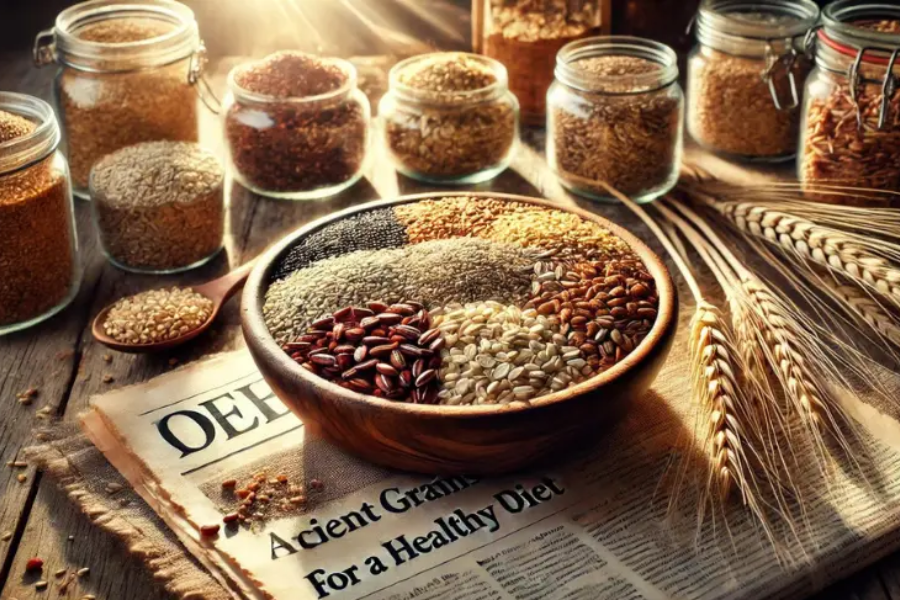Introduction
Have you come across the hype surrounding ancient grains in healthy cereal and wondered what all the fuss is about? You’re in good company. These time-honored grains are making waves in modern diets, offering numerous health benefits that many processed grains often lack. In this blog post, we’ll explore the wonders of incorporating ancient grains into your daily routine, specifically through nutritious cereals. We’ll delve into their health benefits, the variety of ancient grains available, and why they deserve a spot in your breakfast bowl. By the end of this article, you’ll be equipped to make informed choices for a healthier lifestyle, including where to find the best ancient grain cereal.
What Are Ancient Grains?
Ancient grains refer to cereals and seeds that have remained largely unchanged over the past several hundred years. Unlike modern wheat, which has been selectively bred to increase yield and disease resistance, ancient grains maintain their original structure and nutritional profile. Notable examples of ancient grains include quinoa, amaranth, spelt, and farro.
The True Origins
These grains have long been staples in various cultures. For instance, quinoa was revered by the Incas, who referred to it as the “mother of all grains.” Amaranth was a staple in Aztec diets, while spelt was widely consumed in ancient Europe and the Middle East. Beyond their role as food sources, these grains were also prized for their health benefits.
Nutritional Powerhouses
Ancient grains are rich in protein, fiber, vitamins, and minerals, offering a robust nutritional profile. For example, quinoa is a complete protein, meaning it contains all nine essential amino acids. Amaranth is high in calcium, while spelt is a good source of iron and magnesium.
Modern Appeal
Their ancient origins and superior nutritional benefits make these grains appealing to today’s health-conscious consumers. They provide a healthier alternative to processed grains, which often lose essential nutrients during refining.
The Health Benefits of Ancient Grains
So, what sets ancient grains apart from their modern counterparts? The answer lies in their exceptional nutritional profile and the health benefits they offer.
High in Fiber
One of the standout benefits of ancient grains is their high fiber content. Fiber is crucial for maintaining digestive health, reducing cholesterol levels, and regulating blood sugar. For instance, a serving of quinoa provides around 5 grams of fiber, surpassing most refined grains.
Rich in Antioxidants
Ancient grains are packed with antioxidants that help combat inflammation and protect your cells from damage. Antioxidants play a vital role in reducing the risk of chronic diseases such as heart disease and cancer. Grains like teff and millet are particularly high in these essential compounds.
Gluten-Free Options
For those with gluten sensitivities or celiac disease, several ancient grains offer a safe alternative. Quinoa, amaranth, and millet are all naturally gluten-free, providing a nutritious option without the adverse effects of gluten.
Why Choose Ancient Grain Cereal?
You might still be wondering why you should switch to ancient grain cereal. Here are a few compelling reasons:
Sustainability
Ancient grains are often grown using traditional farming practices that are more environmentally friendly. They require fewer resources and are more resilient to changing climate conditions. By choosing ancient grain cereal, you’re supporting sustainable agriculture and reducing your carbon footprint.
Flavor and Texture
Ancient grain cereal offers a unique flavor and texture that sets it apart from conventional options. With its nutty taste and delightful crunch, it can make your breakfast truly enjoyable. Whether you prefer the mild flavor of spelt or the robust taste of farro, there’s an ancient grain cereal to suit your taste.
Popular Ancient Grains
Quinoa: A complete protein that includes all nine essential amino acids. It’s also gluten-free, making it ideal for those with gluten sensitivities.
Amaranth: A gluten-free grain high in protein, fiber, and essential nutrients like iron and magnesium. It has a slightly nutty flavor and is versatile in various dishes.
Farro: An ancient wheat known for its chewy texture and nutty flavor. It’s rich in protein and fiber, perfect for salads, soups, and other recipes.
Spelt: An ancient wheat that is easier to digest than modern wheat. It offers a slightly sweet, nutty taste and is high in protein and fiber.
Millet: A small, gluten-free grain rich in magnesium, phosphorus, and manganese. It’s a staple in many traditional diets and can be used in both sweet and savory dishes.
Incorporating Ancient Grain Cereal into Your Diet
Adding ancient grain cereal to your diet is simple and versatile:
Breakfast Bowl
The easiest way to enjoy ancient grain cereal is in a breakfast bowl. Combine it with milk, yogurt, or a plant-based alternative, and top with fresh fruit, nuts, and seeds for a balanced meal. This combination offers a mix of protein, healthy fats, and carbohydrates to start your day right.
Smoothie Topping
Ancient grain cereal can also be a great addition to smoothies. Sprinkle a handful on top of your smoothie bowl for added texture and nutrition. This is a fantastic way to enhance the flavor and nutrient content of your morning smoothie.
In summary, ancient grains are not just a trend; they’re a nutritional powerhouse that deserves a place in your daily diet. By choosing ancient grain cereal, you’re opting for a healthier, more sustainable, and delicious alternative to processed grains. So why not give it a try and enjoy the myriad benefits these timeless grains have to offer?
Conclusion
Ancient grains in healthy cereal are not just a passing trend; they represent a return to more wholesome, nutrient-dense eating. Their rich nutritional profile, which includes high fiber, essential amino acids, and antioxidants, makes them a valuable addition to any diet. By choosing ancient grain cereals, you’re not only benefiting your health but also supporting sustainable farming practices. These time-tested grains offer unique flavors and textures that can elevate your breakfast routine and provide a more satisfying and nutritious start to your day. Embracing ancient grains is a simple yet effective way to enhance your overall well-being and enjoy a healthier lifestyle.
FAQs
1. What are ancient grains, and how are they different from modern grains?
Ancient grains are cereals and seeds that have remained relatively unchanged for centuries, preserving their original nutritional profile. Unlike modern grains, which have been selectively bred for higher yield and disease resistance, ancient grains like quinoa, amaranth, and spelt retain their traditional structure and nutrients.
2. Are ancient grain cereals a good option for people with gluten sensitivities?
Yes, several ancient grains are naturally gluten-free, making them suitable for individuals with gluten sensitivities or celiac disease. Notable gluten-free options include quinoa, amaranth, and millet. Always check product labels to ensure there is no cross-contamination if you have severe gluten intolerance.
3. What are the health benefits of eating ancient grain cereal?
Ancient grain cereals offer numerous health benefits, including high fiber content, which aids in digestive health and helps regulate blood sugar levels. They are also rich in antioxidants, which can help reduce inflammation and lower the risk of chronic diseases. Additionally, ancient grains often provide essential nutrients like protein, iron, and magnesium.
4. How can I incorporate ancient grain cereal into my diet?
You can easily incorporate ancient grain cereal into your diet by enjoying it in a breakfast bowl with milk or yogurt, topped with fruits, nuts, and seeds. It can also be used as a topping for smoothies or included in recipes for added texture and nutrition. Experiment with different ancient grains to find your favorites and diversify your meals.
5. Where can I find ancient grain cereals?
Ancient grain cereals can be found at health food stores, specialty grocery stores, and online retailers. Look for products that list ancient grains like quinoa, spelt, or farro as primary ingredients. Many supermarkets also carry ancient grain cereals in their health food or organic sections.
Keep up-to-date with breaking news and updates on ytmp3




